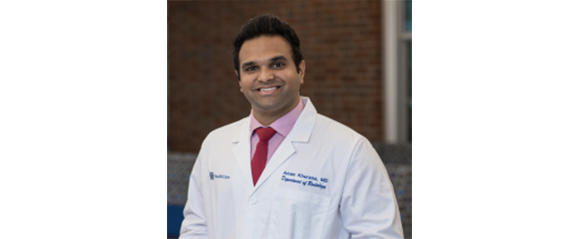Drs. Aman Khurana and Fanny Chapelin Receive Early Career Research Award at Society of Radiologists in Ultrasound (SRU) 2020
What led you and Dr. Chapelin to this research topic?
When we started at University of Kentucky (UK) last fall, (August 2019), we saw two untapped potentials in the Department of Radiology and we jumped on board. First, UK radiologists were collecting data but were not able to analyze it in time because of slow statistics turn around times and second, the opportunity to involve radiology residents in research collaborations by carefully guiding and mentoring them through the process.
Your experience of receiving the award
We are thrilled to receive this award early in our careers but we could not have done without the mentorship of Dr. Adrian Dawkins, Radiology Division Chief, Abdominal Division, who guided the initial data collection and had the original idea behind this research initiative.
What opportunity do you anticipate it may afford?
This award enables us to present this paper/talk to a highly coveted subgroup of radiologists in the annual meeting of Society of Radiologists in Ultrasound (SRU) called the SRU fellows. This group is formed by the core group of radiologists producing cutting-edge research and policy making for ultrasound imaging within North America. This exposure will definitely give us invaluable feedback regarding our research design and future opportunities.
Will the research topic expand?
Yes, we are planning to submit this paper to the official journal of the SRU, "Ultrasound Quarterly". Then we will start collecting more data now that most of the abdominal imaging faculty at UK use US LI-RADS categorization when reporting liver ultrasounds.
When do you anticipate receiving possible news of acceptance for publication in the Ultrasound Quarterly?
Hopefully, very soon!!
Tell us a little about your collaborator Dr. Fanny Chapelin.
Dr. Chapelin is one of the new research assistant professors in the College of Engineering's Joseph Halcomb III, Department of Biomedical Engineering. She joined the department right after her PhD graduation from the Department of Biomedical Engineering at the University of California San Diego (UCSD), with a degree in advanced T-cell imaging.
Drs. Khurana and Chapelin have worked together for 8 years at both Stanford University and University of California San Diego, (UCSD), and have published 6 peer-reviewed original research articles together. They recently secured a pilot grant from the Center for Clinical & Translational Science, (CCTS) at UK on "MR Imaging of tumor associated macrophage changes with therapy”.
On a more personal note with Dr. Khurana.
I have always enjoyed medicine and radiology and was fascinated by “being able to see inside the human body” with medical imaging since childhood when my father would perform 3D US on pregnant mothers creating beautiful portraits of their un-born babies. I came to the United States to explore advances in radiology at the University of California San Franciso, (UCSF), and a few of my initial projects revolved around creating 3D reconstructions of hepatic arterial anatomy, a technology that was somewhat new in 2009 but used so frequently in 2020. This constant changing and rapidly evolving environment of radiology is what drives my passion. I envision building up my research in contrast enhanced US and molecular imaging at UK with collaborations with departments of biomedical engineering and transplant surgery.
I enjoy my time outside work as much as I enjoy working, I bike 8-10 miles on a daily basis and escape to neighboring wilderness for hiking and camping on the weekends. Living in California for the last decade has made us very outdoor-sy and we would frequently surf in the warm waters of the Pacific Ocean in summer and ski the gorgeous west coast peaks in winters.
We love exploring countries (my wife is from France and I am from India and we have family all over Europe and Asia), new cuisines (we cook French, Indian, Vietnamese, Chinese, Thai, Italian, Moroccan, Swiss and Korean at home!!) and American national parks. We have visited the majority of national parks in the western United States over the decade of living in California!!
To learn more: https://www.engr.uky.edu/news/2020/09/drs-khurana-and-chapelin-win-early...
